| Reviews & Columns |
|
Reviews DVD TV on DVD Blu-ray 4K UHD International DVDs In Theaters Reviews by Studio Video Games Features Collector Series DVDs Easter Egg Database Interviews DVD Talk Radio Feature Articles Columns Anime Talk DVD Savant Horror DVDs The M.O.D. Squad Art House HD Talk Silent DVD
|
DVD Talk Forum |
|
|
| Resources |
|
DVD Price Search Customer Service #'s RCE Info Links |
|
Columns
|
|
|
Tokyo!
Liberation Entertainment // Unrated // June 30, 2009
List Price: $34.95 [Buy now and save at Amazon]
As New
York Stories rings in its twentieth anniversary and with Paris, je t'aime not all that far in the rear view mirror, Tokyo is the latest sprawling metropolis to be lavished with its own anthology film. Though it is a Japanese production, Tokyo! explores the city through the eyes of outside talent, turning to Korean director Bong Joon-ho (The Host) as well as Frenchmen Michel Gondry (Eternal Sunshine of the Spotless Mind) and Leos Carax (The Lovers on the Bridge). All three films are, of course, set against the backdrop of Tokyo, they each feature recurring themes of detachment, and -- no surprise, considering the directors on the marquee -- they all shrug off many of the usual cinematic conventions. Reactions to Tokyo! may vary, but it's hardly a film that can be dismissed as routine.
The first and most instantly engaging of the three is Gondry's "Interior Design". This adaptation of "Cecil and Jordan in New York" swaps out the setting of Gabrielle Bell's comic in favor of the Far East, opening as a young Japanese couple arrives in Tokyo to carve out some sort of life together. Akira (Ryo Kase) is a fledgling filmmaker who's thrilled to have booked his master opus -- a batshit psychotic DV flick with an arthouse bunny birth and a Residential-skull-masked slasher on a motorcycle -- in a dingy porno theater. His girlfriend Hiroko (Ayako Fujitani), on the other hand, doesn't seem to have any real ambition. Not only is she unable to score even the most menial job in Tokyo and watches helplessly as her meager savings dwindle, but she fumbles repeatedly at tracking down any sort of vaguely affordable apartment. Hiroko finds herself feeling more and more useless, and since she hasn't accomplished much as a young woman or as a girlfriend, she...well, transforms into something else altogether. It's the sort of intriguingly bizarre twist I'd hope to see from Michel Gondry, and his sensibility prevents that off-kilter shift from ever seeming strange-for-the-sake-of-being-strange and winds up feeling remarkably resonant. Of the three segments that comprise Tokyo!, "Interior Design" is the one that feels the most inexorably rooted in the streets of Tokyo. Despite the surreal shift as Gondry's film draws to a close, the core of its story is perhaps the most conventional but is easily the best acted, most compelling, and best realized of the tree. Like the
best of Gondry's work, it's defined by the interplay between the playful and the melancholy.
Leos Carax' "Merde" is engaging enough at the outset. Tokyo isn't being plagued by attacks from oversized moths or green rubber monsters; no, the threat this time around is a subhuman creature (Carax mainstay Denis Lavant) who periodically crawls out of a manhole, shambles down the street, and swats at and gobbles whatever happens to be in his path. The media dubs this flower-and-money munching beast "The Creature from the Sewers", but really, he seems to be more of a nuisance than an outright threat. That all changes when he stumbles upon a a cache of grenades deep in the underbelly of the city, and he tosses them through a bustling street like rice at a wedding, disinterestedly stepping over a parade of mangled corpses along the way. Facing the death penalty once captured, only a similarly twisted looking attorney imported from France (Jean-Francois Balmer) can translate the gibberish language of 'Merde' -- French for "shit" -- and defend him in court.
"Merde" is an idea in search of a story. As fascinatingly strange as the character is at first, Carax' film is derailed once it turns into a courtroom drama. Having to suffer through every line spoken and translated three times -- Japanese, French, and Merde's squawking gibberish -- quickly grows tedious, the backdrop of Tokyo is almost incidental, and Carax doesn't adequately explore Merde's polarizing celebrity. Transforming a guilelessly destructive creature who feasts on flowers and yen into a murderous racist is jarring and seems like a gross misstep as well. "Merde" seems like it cries out to either be much shorter or, if Carax were to delve into a loathesome creature on trial in the same vein as Citizen Ruth, considerably longer. As structured here, though, "Merde" is uninvolving and on the brink of being grating.
Tokyo!
steadies itself in its third and final segment, though, this time with Bong Joon-ho at the helm. "Shaking Tokyo" is about a nameless hikikomori -- a shut-in -- played by Teruyuki Kagawa (Sukiyaki Western Django). He hasn't stepped foot outside his meticulously arranged house in a full decade, and thanks to an allowance from his father and the convenience of a telephone, there's little need to either. This man has so thoroughly insulated himself from the outside world that even when the parade of delivery men drop something off for him, he can't be bothered to look them in the eye. This inadvertently changes when his weekly pizza is delivered by a young girl, but before he can react to his first eye contact in eleven years, an earthquake strikes and sends her tumbling lifelessly into his living room. He's caught entirely off-guard: not only is this the closest thing to interaction he's had in a decade, but it's with a strikingly beautiful girl whose body is adorned with tattooed buttons. He eventually discovers a button marked "coma", and when he presses it, she's up and out the door. He's smitten enough to venture out of his hermetically sealed life to try to find her, but as he claws his way out, she shuts herself in...
Like the film's other two segments, "Shaking Tokyo" is stylish and intriguingly odd. Bong's direction suits the segment's two halves perfectly -- bleak and bleary-eyed inside the man's underlit house and blindingly bright once he steps out into the half-forgotten world outside. It's a story I would've liked to have seen extended, really. The first and second acts are cleanly delineated, but the finale amounts to little more than the press of a button. The script seems cut off at the knees to fit a predetermined runtime, and as much as I enjoyed "Shaking Tokyo" as a whole, that still comes as somewhat of a disappointment.
Though Tokyo! is admittedly uneven, it's impossible to deny just how distinctive and startlingly imaginative these three directors' visions of the city can be. For cineastes seeking out something unconventional on Blu-ray, Tokyo! is near-essential viewing. Recommended.
Video
The
three films that comprise Tokyo! were each shot in entirely different ways, and it follows that this Blu-ray disc's high definition presentation is similarly erratic. Shot on 35mm, by far the glossiest of the three is Michel Gondry's "Interior Design". It's a touch softer than usual but is still crisp and nicely detailed, and the 1.85:1 image benefits from a reasonably three-dimensional appearance. The pleasantly grainy texture of Masami Inomoto's cinematography is retained as well. "Merde" is more of a mixed media experiment. Portions of it were shot on HD video and even a cell phone camera, but Leos Carax most frequently turns to standard definition DV. This segment clearly doesn't offer all that much of upgrade over the DVD release, and it's slathered in digital noise from the original photography. Letterboxed further to an aspect ratio of 2.20:1 or so, Bong Joon-ho's "Shaking Tokyo" looks to have been lensed on 16mm. It's a stylized piece, flattening out the contrast, washing out black levels, and keeping the image awash in film grain as Takeshi is walled up inside his apartment. Once he steps out, the contrast screams toward the other direction entirely, and its whites are blown-out and blooming in the light of day. Detail and clarity are fine but unremarkable in the film's final segment.
Kind of a rarity in the here and now, Tokyo! has been encoded in MPEG-2. Though most of the capacity of this BD-50 is utilized, around a third of its space is devoted to extras, limiting the breathing room for the film proper. The movie doesn't seem to suffer much from leaning on MPEG-2, though, although some of the stretches shot on film do strike me as having an undefinably digital look to them. Tokyo! otherwise looks about as great as the limits of the original photography will allow. It's not a reference quality disc by any stretch, but it's generally good enough, and I doubt there's all that much room for improvement.
Audio
There's a tiny bit of English and a smattering of French, but this 24-bit, 7.1 DTS-HD Master Audio soundtrack is predominately -- as the film's title suggests -- in Japanese. It's a remarkably active mix that takes full advantage of the many channels at its fingertips and is bolstered by a thick, resonant low-end. In "Interior Design" in particular, the constant splashes of color in the surrounds leave Tokyo sounding every bit the bustling and lively metropolis that it is. The roar of traffic throughout, angry mobs crying out for Merde's death, and the suburbs crumbling under the weight of an earthquake are all fleshed out by a strong sense of directionality. Even the score impresses in this sense as the violently strummed acoustic guitar in "Shaking Tokyo" bounds from one speaker to the next. Considering the slew of chucked grenades and foundation-rattling earthquakes, it ought to go without saying that bass response is consistently robust as well. There really aren't any flaws of note. A light and easily ignored hiss lurks in the background of "Shaking Tokyo", and the stylized soundtrack of "Merde" makes use of deliberately strained kaiju horns. Tokyo! is bolstered by a particularly strong sound design, and it benefits wonderfully from such a high resolution lossless soundtrack.
A second DTS-HD Master Audio track is provided in stereo, and subtitles are offered in English and French.
Extras
After
tallying up the interviews and behind-the-scenes footage, the extras on Tokyo! run longer than the film itself.
First up is a set of interviews. Accompanied by co-writer Gabrielle Bell, Michel Gondry speaks about how he avoided turning to his usual crew and how the language barrier with the Japanese wound up working to his advantage, what Hiroko's bizarre transformation represents thematically, and how his process as a director is to chuck out ideas that make some measure of sense. Leos Carax then speaks about how inhumanly quickly "Merde" was written and shot. Much of the discussion swirls around the character of Merde: where he originated, his primal nature that shares more than a couple of similarities to Gojira, and likening him further to Charlie Chaplin and Tintin. Even though a full decade has passed since the release of his last film, Carax notes that he doesn't look at his segment of Tokyo! as a comeback so much as a return home. Finally, Bong Joon-ho speaks about how he dealt with his perfectionism during the shoot as well as the language barrier with the Japanese crew, noting that some of his initial assumptions about the inflexibility of the local film crews were quickly proven incorrect. Bong also describes Tokyo as a lonely city despite its size and sprawling population, and this plays no small role in his segment of the film.
Each of the three stories that make up Tokyo! is accompanied by its own half-hour making-of clip. The featurette delving into "Interior Design" is the only one to follow a traditional making-of structure, anchored primarily around comments by Michel Gondry. The director pulls back the curtain much of the way but resists the temptation to delve into how the computer graphics and visual effects were executed, not wanting to spoil all of the magic of the silver screen. This featurette also explores how Gondry shrugs off rehearsals and avoids calling cut whenever possible. It's brimming with detailed casting notes and behind-the-scenes shots, including some
glimpses of the bird's eye camerawork for a cramped Tokyo apartment.
The other two half-hour featurettes dispense with the interviews and are instead centered around candid footage from the sets. Much of the behind-the-scenes look at "Merde" focuses on the creature's initial assault, prepping the character in his underground lair (complete with tattoos being applied as well as debates about eating money and licking a grenade), and, in most detail, rehearsing Merde's explosive siege on the streets of Tokyo. There's even some footage of the Japanese crew arguing about how rigidly defined the action is in the script and how unwilling Leos Carax is to stray from it. Clocking in at 33 minutes, "Making of 'Shaking Tokyo'" is the longest of the three featurettes, and it prefers to leer over Bong Joon-ho's shoulder from behind the director's chair. Most of the attention is aimed as Bong's meticulous, precise directorial style, such as bringing actors to the monitor to review their performances and timing out action down to the second.
There isn't any filler or vapid promotion on display here, and it's all rewarding viewing. Tokyo!'s extras have been needlessly upscaled from standard definition to 1080p24, and since they're encoded in MPEG-2 as well, they devour quite a bit of the space on this BD-50. I guess having a big enough bit bucket on-hand means there's no need to fret about efficiency. This footage isn't upscaled particularly well, though, and these two hours-plus of footage are littered with interlacing artifacts. It's also worth noting that the extras aren't subtitled by default, and English-speaking users will have to fiddle with the 'Subtitle' buttons on their remotes to get much out of them.
Rounding out the extras are a trailer and a minute-and-a-half montage of production stills. The menus are creatively themed around each individual film, although strangely, there's no pop-up menu this time around.
The Final Word
The three stories that make up this anthology may be uneven, but Tokyo! is among the most inventive and wildly imaginative films on Blu-ray, and viewers seeking out something left-of-center on the format ought to find it well-worth a look. Recommended.
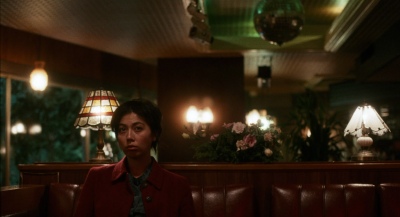 |
| [click on the thumbnail to enlarge] |
The first and most instantly engaging of the three is Gondry's "Interior Design". This adaptation of "Cecil and Jordan in New York" swaps out the setting of Gabrielle Bell's comic in favor of the Far East, opening as a young Japanese couple arrives in Tokyo to carve out some sort of life together. Akira (Ryo Kase) is a fledgling filmmaker who's thrilled to have booked his master opus -- a batshit psychotic DV flick with an arthouse bunny birth and a Residential-skull-masked slasher on a motorcycle -- in a dingy porno theater. His girlfriend Hiroko (Ayako Fujitani), on the other hand, doesn't seem to have any real ambition. Not only is she unable to score even the most menial job in Tokyo and watches helplessly as her meager savings dwindle, but she fumbles repeatedly at tracking down any sort of vaguely affordable apartment. Hiroko finds herself feeling more and more useless, and since she hasn't accomplished much as a young woman or as a girlfriend, she...well, transforms into something else altogether. It's the sort of intriguingly bizarre twist I'd hope to see from Michel Gondry, and his sensibility prevents that off-kilter shift from ever seeming strange-for-the-sake-of-being-strange and winds up feeling remarkably resonant. Of the three segments that comprise Tokyo!, "Interior Design" is the one that feels the most inexorably rooted in the streets of Tokyo. Despite the surreal shift as Gondry's film draws to a close, the core of its story is perhaps the most conventional but is easily the best acted, most compelling, and best realized of the tree. Like the
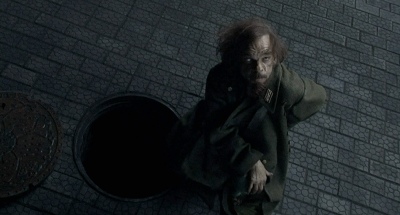 |
| [click on the thumbnail to enlarge] |
Leos Carax' "Merde" is engaging enough at the outset. Tokyo isn't being plagued by attacks from oversized moths or green rubber monsters; no, the threat this time around is a subhuman creature (Carax mainstay Denis Lavant) who periodically crawls out of a manhole, shambles down the street, and swats at and gobbles whatever happens to be in his path. The media dubs this flower-and-money munching beast "The Creature from the Sewers", but really, he seems to be more of a nuisance than an outright threat. That all changes when he stumbles upon a a cache of grenades deep in the underbelly of the city, and he tosses them through a bustling street like rice at a wedding, disinterestedly stepping over a parade of mangled corpses along the way. Facing the death penalty once captured, only a similarly twisted looking attorney imported from France (Jean-Francois Balmer) can translate the gibberish language of 'Merde' -- French for "shit" -- and defend him in court.
"Merde" is an idea in search of a story. As fascinatingly strange as the character is at first, Carax' film is derailed once it turns into a courtroom drama. Having to suffer through every line spoken and translated three times -- Japanese, French, and Merde's squawking gibberish -- quickly grows tedious, the backdrop of Tokyo is almost incidental, and Carax doesn't adequately explore Merde's polarizing celebrity. Transforming a guilelessly destructive creature who feasts on flowers and yen into a murderous racist is jarring and seems like a gross misstep as well. "Merde" seems like it cries out to either be much shorter or, if Carax were to delve into a loathesome creature on trial in the same vein as Citizen Ruth, considerably longer. As structured here, though, "Merde" is uninvolving and on the brink of being grating.
Tokyo!
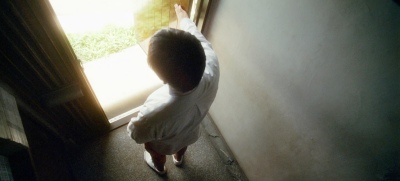 |
| [click on the thumbnail to enlarge] |
Like the film's other two segments, "Shaking Tokyo" is stylish and intriguingly odd. Bong's direction suits the segment's two halves perfectly -- bleak and bleary-eyed inside the man's underlit house and blindingly bright once he steps out into the half-forgotten world outside. It's a story I would've liked to have seen extended, really. The first and second acts are cleanly delineated, but the finale amounts to little more than the press of a button. The script seems cut off at the knees to fit a predetermined runtime, and as much as I enjoyed "Shaking Tokyo" as a whole, that still comes as somewhat of a disappointment.
Though Tokyo! is admittedly uneven, it's impossible to deny just how distinctive and startlingly imaginative these three directors' visions of the city can be. For cineastes seeking out something unconventional on Blu-ray, Tokyo! is near-essential viewing. Recommended.
Video
The
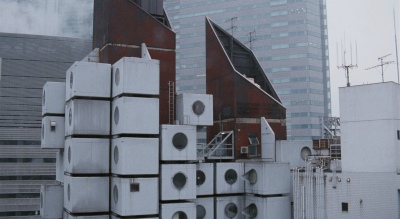 |
| [click on the thumbnail to enlarge] |
Kind of a rarity in the here and now, Tokyo! has been encoded in MPEG-2. Though most of the capacity of this BD-50 is utilized, around a third of its space is devoted to extras, limiting the breathing room for the film proper. The movie doesn't seem to suffer much from leaning on MPEG-2, though, although some of the stretches shot on film do strike me as having an undefinably digital look to them. Tokyo! otherwise looks about as great as the limits of the original photography will allow. It's not a reference quality disc by any stretch, but it's generally good enough, and I doubt there's all that much room for improvement.
Audio
There's a tiny bit of English and a smattering of French, but this 24-bit, 7.1 DTS-HD Master Audio soundtrack is predominately -- as the film's title suggests -- in Japanese. It's a remarkably active mix that takes full advantage of the many channels at its fingertips and is bolstered by a thick, resonant low-end. In "Interior Design" in particular, the constant splashes of color in the surrounds leave Tokyo sounding every bit the bustling and lively metropolis that it is. The roar of traffic throughout, angry mobs crying out for Merde's death, and the suburbs crumbling under the weight of an earthquake are all fleshed out by a strong sense of directionality. Even the score impresses in this sense as the violently strummed acoustic guitar in "Shaking Tokyo" bounds from one speaker to the next. Considering the slew of chucked grenades and foundation-rattling earthquakes, it ought to go without saying that bass response is consistently robust as well. There really aren't any flaws of note. A light and easily ignored hiss lurks in the background of "Shaking Tokyo", and the stylized soundtrack of "Merde" makes use of deliberately strained kaiju horns. Tokyo! is bolstered by a particularly strong sound design, and it benefits wonderfully from such a high resolution lossless soundtrack.
A second DTS-HD Master Audio track is provided in stereo, and subtitles are offered in English and French.
Extras
After
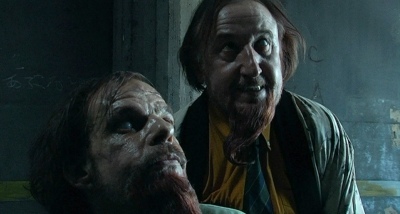 |
| [click on the thumbnail to enlarge] |
First up is a set of interviews. Accompanied by co-writer Gabrielle Bell, Michel Gondry speaks about how he avoided turning to his usual crew and how the language barrier with the Japanese wound up working to his advantage, what Hiroko's bizarre transformation represents thematically, and how his process as a director is to chuck out ideas that make some measure of sense. Leos Carax then speaks about how inhumanly quickly "Merde" was written and shot. Much of the discussion swirls around the character of Merde: where he originated, his primal nature that shares more than a couple of similarities to Gojira, and likening him further to Charlie Chaplin and Tintin. Even though a full decade has passed since the release of his last film, Carax notes that he doesn't look at his segment of Tokyo! as a comeback so much as a return home. Finally, Bong Joon-ho speaks about how he dealt with his perfectionism during the shoot as well as the language barrier with the Japanese crew, noting that some of his initial assumptions about the inflexibility of the local film crews were quickly proven incorrect. Bong also describes Tokyo as a lonely city despite its size and sprawling population, and this plays no small role in his segment of the film.
Each of the three stories that make up Tokyo! is accompanied by its own half-hour making-of clip. The featurette delving into "Interior Design" is the only one to follow a traditional making-of structure, anchored primarily around comments by Michel Gondry. The director pulls back the curtain much of the way but resists the temptation to delve into how the computer graphics and visual effects were executed, not wanting to spoil all of the magic of the silver screen. This featurette also explores how Gondry shrugs off rehearsals and avoids calling cut whenever possible. It's brimming with detailed casting notes and behind-the-scenes shots, including some
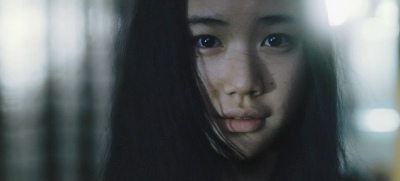 |
| [click on the thumbnail to enlarge] |
The other two half-hour featurettes dispense with the interviews and are instead centered around candid footage from the sets. Much of the behind-the-scenes look at "Merde" focuses on the creature's initial assault, prepping the character in his underground lair (complete with tattoos being applied as well as debates about eating money and licking a grenade), and, in most detail, rehearsing Merde's explosive siege on the streets of Tokyo. There's even some footage of the Japanese crew arguing about how rigidly defined the action is in the script and how unwilling Leos Carax is to stray from it. Clocking in at 33 minutes, "Making of 'Shaking Tokyo'" is the longest of the three featurettes, and it prefers to leer over Bong Joon-ho's shoulder from behind the director's chair. Most of the attention is aimed as Bong's meticulous, precise directorial style, such as bringing actors to the monitor to review their performances and timing out action down to the second.
There isn't any filler or vapid promotion on display here, and it's all rewarding viewing. Tokyo!'s extras have been needlessly upscaled from standard definition to 1080p24, and since they're encoded in MPEG-2 as well, they devour quite a bit of the space on this BD-50. I guess having a big enough bit bucket on-hand means there's no need to fret about efficiency. This footage isn't upscaled particularly well, though, and these two hours-plus of footage are littered with interlacing artifacts. It's also worth noting that the extras aren't subtitled by default, and English-speaking users will have to fiddle with the 'Subtitle' buttons on their remotes to get much out of them.
Rounding out the extras are a trailer and a minute-and-a-half montage of production stills. The menus are creatively themed around each individual film, although strangely, there's no pop-up menu this time around.
The Final Word
The three stories that make up this anthology may be uneven, but Tokyo! is among the most inventive and wildly imaginative films on Blu-ray, and viewers seeking out something left-of-center on the format ought to find it well-worth a look. Recommended.
|
| Popular Reviews |
| Sponsored Links |
|
|
| Sponsored Links |
|
|
| Release List | Reviews | Shop | Newsletter | Forum | DVD Giveaways | Blu-Ray | Advertise |
|
Copyright 2024 DVDTalk.com All Rights Reserved. Legal Info, Privacy Policy, Terms of Use,
Manage Preferences,
Your Privacy Choices | |||||||













